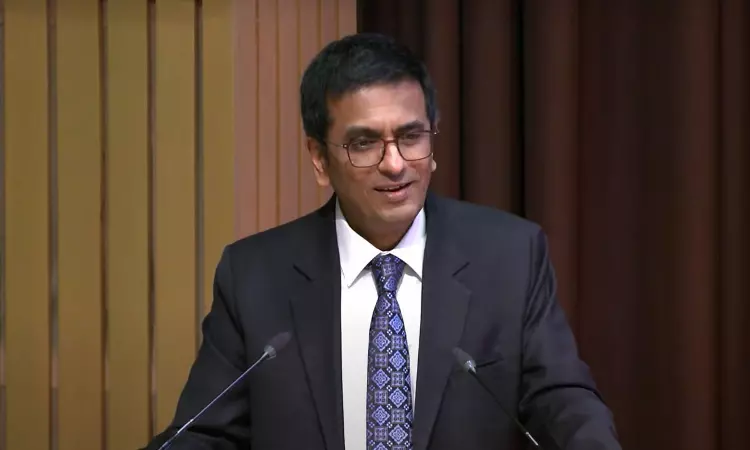- Home
- /
- Top Stories
- /
- Ableist Perspectives Must Be...
Ableist Perspectives Must Be Abandoned For Equal Participation Of Persons With Disabilities: CJI DY Chandrachud
LIVELAW NEWS NETWORK
28 July 2024 9:29 AM IST
Advocating for a more inclusive approach towards persons with disabilities, Chief Justice of India DY Chandrachud said that our physical infrastructure and some of our policy considerations are ableist. They stem from lack of participation and they also further entrench the lack of participation of persons with disabilities, forming an endless loop of exclusion, he said."Legal framework...
Advocating for a more inclusive approach towards persons with disabilities, Chief Justice of India DY Chandrachud said that our physical infrastructure and some of our policy considerations are ableist. They stem from lack of participation and they also further entrench the lack of participation of persons with disabilities, forming an endless loop of exclusion, he said.
"Legal framework aside, our architectural models, intellectual resources, and choices of physical or institutional design sometimes adopt singular ableist perspective. The law now identifies that these barriers create disabilities and exclude persons from equal participation in social, economic and cultural terms. Under- representation of persons with disabilities due to these barriers in educational institutions, workforce and decision-making bodies also excludes them from public discourse. This of course violates a whole range of their civic rights, compromises their citizenship and fundamental freedoms. This exclusion also robs our public discourse of valuable inputs. We are left with a deluge of ableist perspectives that overcrowd our social conscience and weigh heavily on the way we see the world," he siad.
In his inaugural address at the India Accessibility Summit and State Disability Commissioners' Conclave 2024, the CJI said that when the Persons with Disabilities Act 1995 was made, it was mostly based on an understanding of 'disability' as an issue in the individual bodies, exempting social barriers as the cause of the problem persons with disabilities faced. However, the Rights of Persons with Disabilities Act 2016 took a deeper look inward and identified the social and institutional barriers as the cause of disability. "This meant we needed to work on enhancing our preparedness to accommodate persons with disabilities in public life and minimize barriers to their access. We could not simply pathologize the individual with the impairment and consign them to a life of isolation from the public sphere. We are now under a duty to build better, inclusive public lives for our citizens," he said.
The Convention on the Rights of Persons with Disabilities and the 2016 Act thus lay great emphasis on participation. He said greater participation would mean better engagement with issues, a more nuanced understanding of our flawed systems, and a shift in perspective toward persons with disabilities. Reference was made to a Vidhi report about urban planning and institutional design, which found out that the 3% reservation in poverty alleviation programs under the 1995 Act was remarkably successful in Karnataka. This was due to the 'Participatory Governance in Disability' policy of the state government. In India, Corporate Social Responsibility (CSR) initiatives paved the way for inclusive hiring practices, with some HR policies linking managerial performance to the diversity of their hiring decisions. Initially, these practices were merely about legal compliance, but they have since proven to be better economic and institutional choices, with evidence showing that hires from diverse backgrounds perform exceptionally well, debunking outdated ableist notions.
CJI also spoke about the need to acknowledge the various kinds of disabilities, particularly Invisible disabilities or Non-Visible Disabilities (NVDs), Studies show that a majority of people with NVDs choose not to disclose them, fearing stigma and bias at workplaces. This stigma stems from our perceptions that disabilities are deficits. He pointed out that India has one of the largest populations of persons with autism, and developmental and neurological conditions in the world.
Active diagnosis, education, and awareness campaigns will go a long way in overcoming the stigma and prejudice around NVDs, he stressed.
Though our Constitution does not specifically mention disability as a proscribed ground for discrimination, CJI said, the Supreme Court has held that the Constitutional rights and protections inhere equally in persons with disabilities.
"The jurisprudence on the rights of persons with disabilities has evolved from negative non-discrimination rights to positive, affirmative duties on state as well as private persons. Ranging from non-implementation of the law, discrimination in service rules, and denial of support facilities such as scribes in exams and wheelchairs at airports- the Supreme Court, and the High Courts are frequently the sites of some of these battles," he said.
He also spoke about the efforts taken by the judiciary to enhance accessibility. Dedicated infrastructural facilities, as well as technological aids such as close- captioned live streams, OCR-enabled judgments, hyperlinked cause lists, and engaging sign-language interpreters for advocates or parties with hearing impairments, are some of such measures.
"In conclusion, I wish to underline that the proverbial 'shameful walls of exclusion' never come crashing down. They must be slowly and patiently chiseled away by consolidated efforts, cooperation, and dialogue," he said.
"Laws and technology are but instruments of change. Disability and accessibility are both complex social phenomena and the solutions lie in social dialogue. Dismissed as objects of ridicule, exploitation, and segregation, persons with disabilities have long endured institutional indifference. An accessible, dignified public life for all, can be achieved by deliberate dents at the vestiges of this indifference," Chief Justice said.


